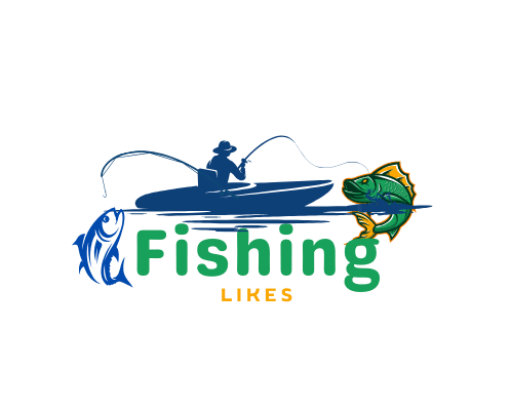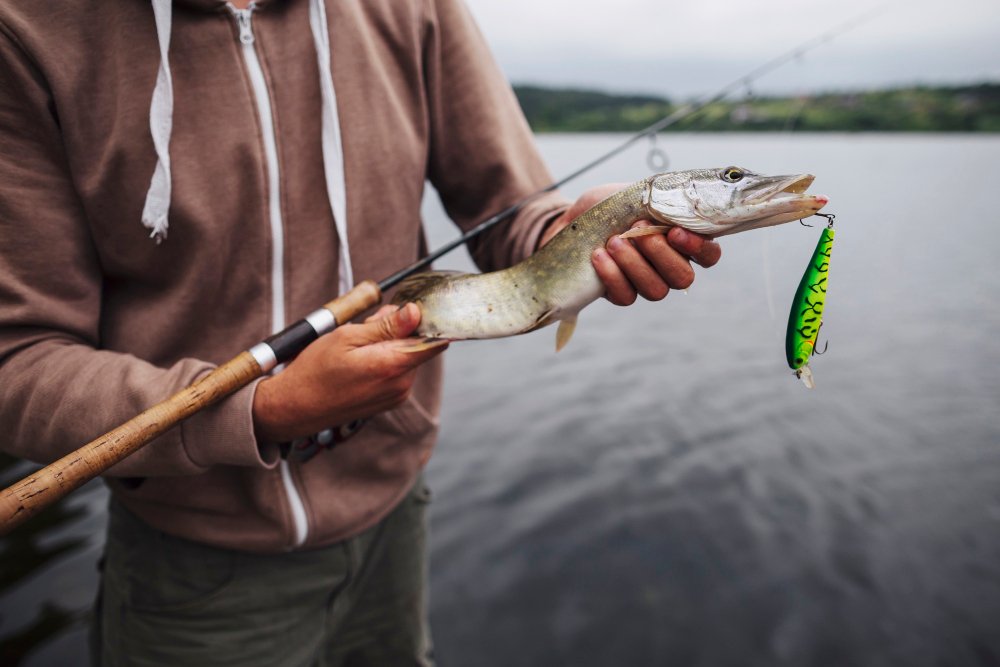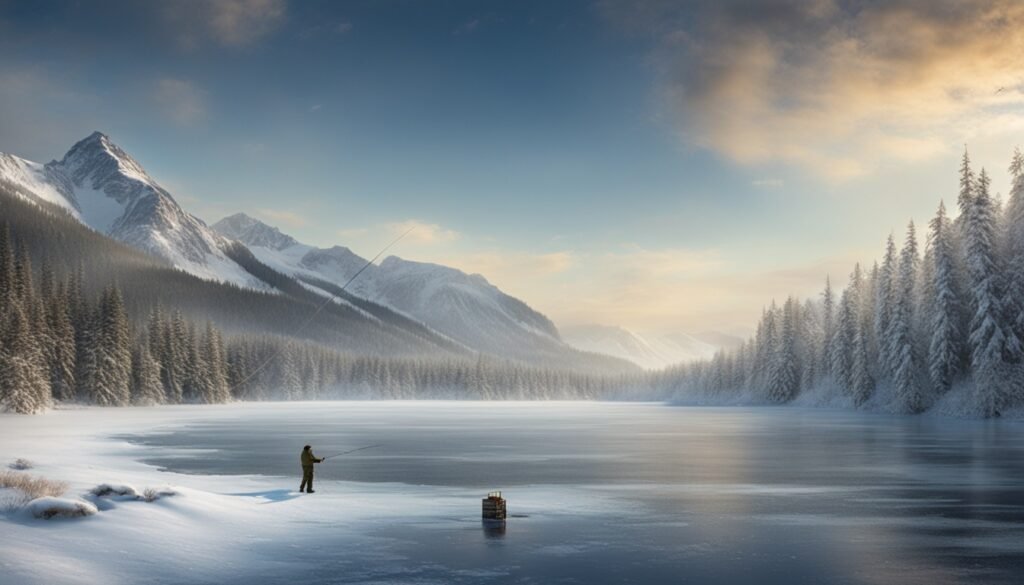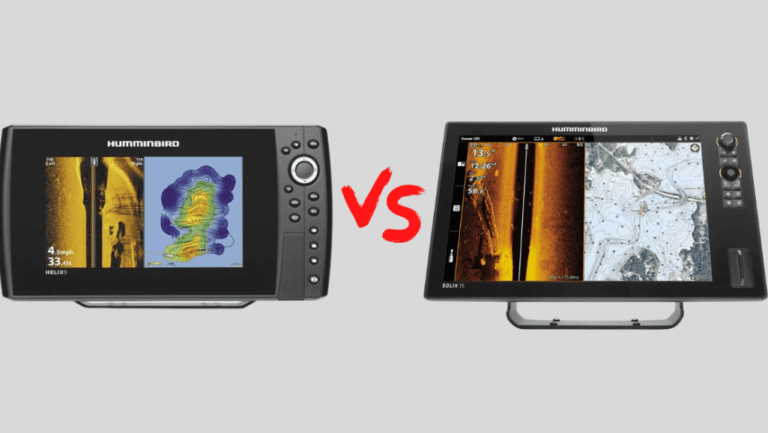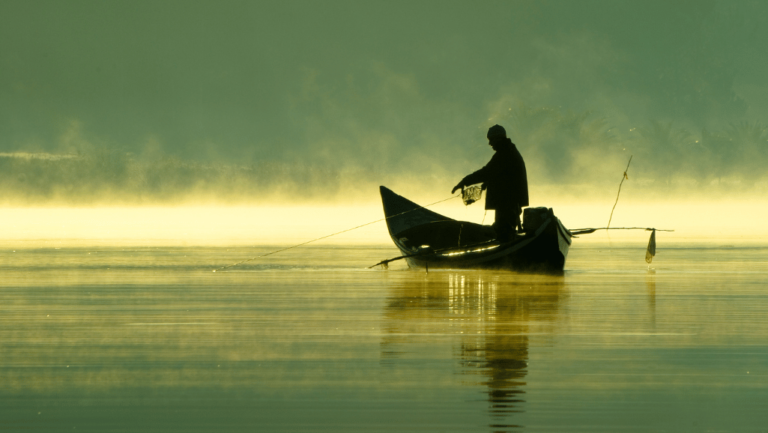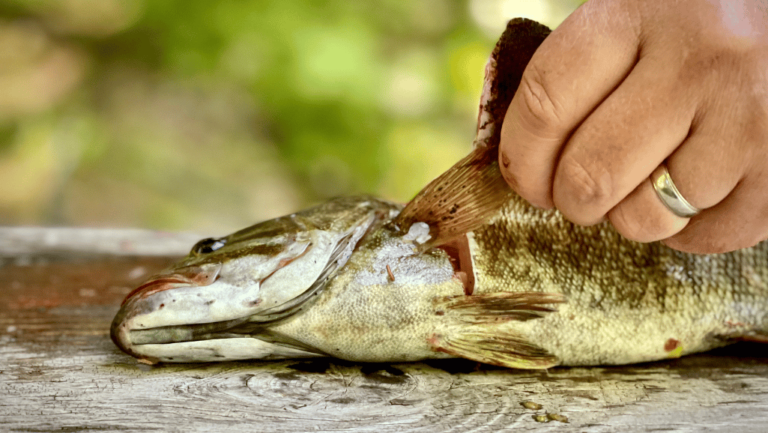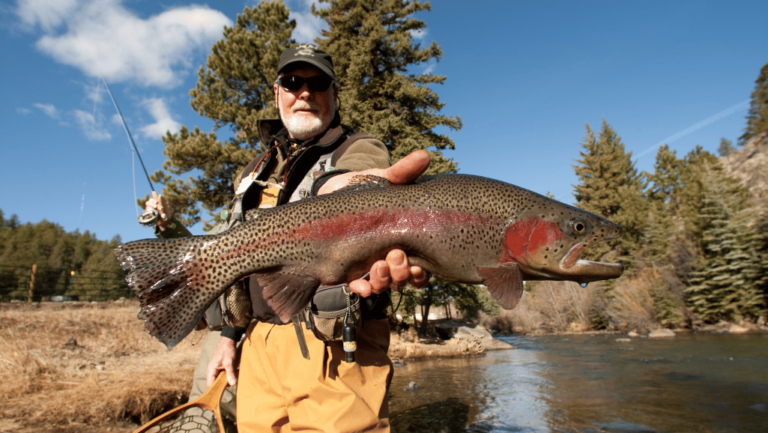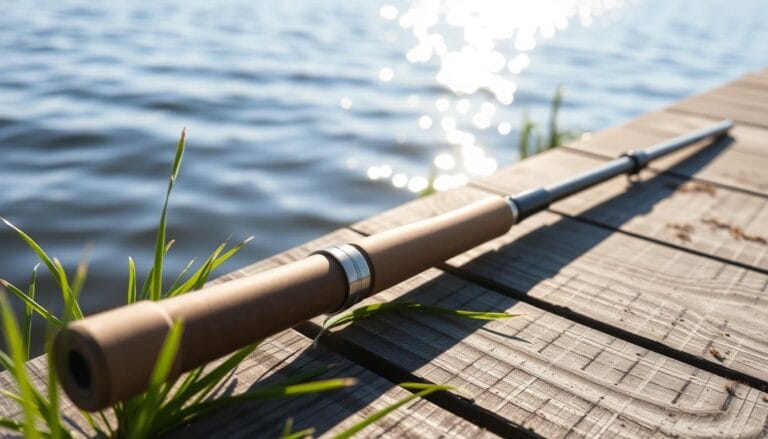Setting out to catch Northern pike means you’re after big, exciting fish. They are known for being aggressive and fun to catch. Knowing what bait and methods to use is like getting a special invite to their world under the water. Fall is a great time to catch pike because they are very hungry. They eat a lot to get ready for the winter. This makes it a perfect time for fishermen, and using the right bait is key to success.
Key Takeaways
- Some of the world’s largest Pike can exceed 40 pounds, with rare specimens topping the 50-pound mark.
- Pike prefer water temperatures around 60ºF.
- Line weights for pike fishing vary; a 12lb monofilament or braid is sufficient for small pike, while a 20lb braid is recommended for larger pike.
- Steel leaders are the preferred method of attaching hooks when fishing for pike.
- An 8wt rod is recommended for fly fishing for pike, with the option to move to a 9 or 10wt rod for big water and big fish.
The Importance of Choosing the Right Pike Bait
Choosing the best pike bait is key to a great fishing trip. You need to know a lot about pike behavior and the best times to fish. This helps you understand where pike move and what they like to eat. It makes it more likely you’ll catch one.
Understanding Pike Behavior
Pike are always looking for something to eat. They like fish like yellow perch and walleye. The best bait for pike acts like the real food they hunt.
The size of the bait matters too. Most caught pike weight between 3 to 7 pounds. If you’re lucky, you might catch a much bigger one.
Seasonal Adjustments
In fall, pike move from shallow to deeper waters. They follow their food. Anglers should change their bait and methods to match this.
Using the right fishing gear is also important. For smaller pike, a reel that can handle 15-pound lines is good. But for the big ones, go for 30 to 40-pound lines.
Imitation and Attraction
Copying the look and movement of pike’s food is crucial. Use lures that move like real fish. Spoils in gold and silver are great for this. They look like fish and attract pike well.
Cold weather makes pike more likely to bite. This is around 10°C (50°F). So, use lures that look real then. These are times when you’re more likely to get a bite.
Also, scouting the area you’ll be fishing helps a lot. Use maps to find good spots. Things like logs or weeds are good places for pike. You can even use wire bite leaders to protect your line. This might change how the lure moves a bit, but it’s worth it. With good prep and gear, you can have an amazing pike fishing trip.
Top-rated Pike Baits for Fall Fishing
Autumn is the perfect time for catching pike. The weather gets cooler, and these fish start eating more to stock up for winter. With the right bait, you have a good chance of catching them because they become very active.
Why Fall is Prime Season for Pike Fishing
As it gets colder, big pike start looking for baitfish almost a third of their size. So, a 42-inch, 20-pounder will likely go for a 14-inch bait rather than a small 3-inch one. This strategy means fall is ideal for using the best pike baits that match what they usually eat.
Recommendations for Autumn Baits
For the best pike lures and baits in the fall, check out these tips:
- Paddle Tail Swimbaits: These lures have a natural swimming look that pike can’t resist. Look for sizes like the Storm Wildeye Swim Shad in 5, 6, and 9 inches.
- Spoons: A 4-inch wobbling spoon is a must-have. Dardevle and Thompson are great choices for their wounded prey wobble.
- Tandem Bass Spinnerbaits: Pick the bigger ones, at least half an ounce. They work well if you’re looking to catch different species too.
- Leaders: Use wire or fluorocarbon leaders to protect your line from pike teeth. Fluorocarbon is best because it’s nearly invisible, giving you an edge in catching more than just pike.
For more tips on the best pike baits and more, visit Midwest Outdoors.
Paddle Tail Swimbaits: An Irresistible Choice
Paddle tail swimbaits are top picks for anglers aiming at pike, especially in the fall. By October 22nd, the water had reached 42.5°F, triggering pike’s hunting mode. This is why these swimbaits work so well. Reviews highlight their realistic movement, just like small fish that pike love to eat.
Fishing experts like Gary Rosenberg and Doug Stange spent 20 nights in the water. They found paddle tail swimbaits to be very effective. They come in different sizes and are designed to catch the eye of pike. This is key for fishing just before sunrise in shallow waters.
When fishing rocky places or small hills under the water in 10 to 14 feet, these swimbaits are praised. Using the right rod and line, like a 5-foot fluoro leader, can make a big difference. Experts suggest this setup boosts your odds.
- Varied sizes of Berkley PowerBait Hollow Belly swimbaits cater to different fishing scenarios.
- Predawn and rocky-gravelly flats are prime spots for pike during fall fishing.
- Using a 7-7.5 foot rod with Berkley FireLine Ultra 8 boosts your effectiveness.
An expert tip is to fish deep rock edges or humps with paddletails, especially in Canada. This can make pike bite deeply, showing how well these swimbaits work.
Including paddle tail swimbaits in your kit this autumn can boost your pike fishing. Many reviews and pros support this tip.
Spoons and Their Effective Action
For over 60 years, spoons have proven their worth in catching pike. They are a go-to lure for many skilled anglers because of their broad use in different fishing situations.
The Versatility of Spoons
Spoons excel at looking like injured prey, which attracts pike. Their unique wobble action is what makes them stand out. You can find them in various colors and sizes to fit the water’s look and what pike usually eats.
- On sunny days, silver spoons are more effective, while gold or copper are recommended for cloudy days.
- Anglers also consider water clarity: natural colors for clear waters, brighter colors for mesotrophic lakes, and fluorescent shades for muddy waters.
Techniques for Using Spoons
To get the most out of spoons, anglers use some smart tricks:
- Varying retrieval speeds to mimic the erratic movement of prey.
- Picking spoons with back finishes like nickel, brass, or copper to look like local prey.
- Using enhancements such as a split ring to increase spoon action, or changing to a single hook for easier fishing in weeds.
In 2018, Mark McCauley and Mike Podracky caught some big pike, up to 50¼ inches. They used spoons like Dr. Spoon in a variety of colors. This shows how important picking the right spoon is for pike fishing.
Famous spoons like Luhr-Jensen Krocodile and Len Thompson have helped catch some record-breaking pike. For example, Bill Tenney caught a 29-pounder. These spoons are well-loved on lakes like Kississing and Neosap.
By knowing how, when, and what spoon to use, anglers can increase their chances of a great pike catch.
Casting Techniques for Maximum Pike Success
Getting casting techniques right can boost your pike fishing game. By using the best methods, tools, and knowing about the place, you can catch more pike.
Depth and Retrieval Methods
Changing how deep you cast and keeping a steady pace when reeling is key. This was proven when Bill Tenney caught a 29-pound pike using a Luhr-Jensen Krocodile. Others, like Mark McCauley, have luck with small metal spoons in deep Alaskan waters.
It’s important to cast according to the water’s temperature. Pikes eat more in 55-60 degree water, so you should fish deeper then. It doesn’t matter if you use swimbaits, spinnerbaits, or jigs. Knowing what pikes like in each season is very important.
Playing with Wind and Weather
Wind and weather can help you in pike fishing. By casting your line where the wind is blowing, you can place your bait in the right spot. This is because the wind pushes food towards the shore, which attracts pikes.
Picking the right bait for different kinds of weather is a must. The bait’s color and shine change how well it works. For instance, shiny spoons work better in dark, murky water.
Practicing these casting methods will make you a better angler. Knowing how to reel in a pike and using the weather to your advantage brings better results.
Best Pike Bait for Winter Adventures
As the weather gets colder, pike start acting differently. Anglers need to change their game to catch them. Knowing what bait works best in winter is crucial for fishing success.
Understanding Winter Pike Behavior
In winter, pike chill out quite literally. They slow down and hang out in deep, cold places. Look for them near rocks, sharp drops, and windy spots where fish gather. Learning how they behave is key to fishing for them in winter.
Bait Strategies for Cold Water
When the water is cold, certain baits work wonders. Things like jigs with live bait or big minnows can get you a lot of action. These baits look and move like what pike normally eat. For the best proof, a big pike hit a shiner not much bigger than your thumb. When you’re fishing, expect to get a handful of nibbles with tiny livebaits. Fish finders also help a ton by pinpointing pike hiding in the chill.
The Role of Live Baits in Pike Fishing
Live baits for pike fishing mimic natural prey well. Fishing with live bait, like minnows and small fish, boosts success. Using these baits lets anglers mirror prey movements that attract pike.
Simply hooking and casting live bait won’t cut it. Anglers need to present live baits properly for best results. Setting up baits using the right rigs and focusing on strategic spots can bring more and bigger pike.
Choosing the right bait size is critical. For big pike, 4- to 7-inch baits work well, while 8 to 12 inches scare off small pike. The gear you use, like St. Croix Avid rods, helps with bait placement and sensing bites.
Watching your rods closely and being patient during hook sets raises success. Keeping baits healthy is also a must when going for pike. Using the Engel Bait Cooler keeps baits fresh. It’s a key step in successful pike fishing.
For the best pike fishing, choose rods that are sensitive yet strong. They help feel bites and set hooks in time. Spreading out rods to fish with more than one bait works great, as pike are aggressive. They often chase live baits, making the right bait and strategy crucial.
Using Technology to Find Pike Hotspots
Modern tech is changing pike fishing for the better. Tools like fish finders and GPS help anglers find the best places to catch pike. Since pike are found in many cold places around the world, these tools are a must-have for fishing trips.
Utilizing Fish Finders
Fish finders are great for seeing what’s going on under the water in real-time. They can spot fish and features where pike like to hide. Anglers use this info to cast their lines in places where they are more likely to catch a pike.
Reading Underwater Structures
To find pike, knowing about the underwater world is key. Drop-offs, plants, and rocks are spots where pike might be waiting. Features like sonar and GPS help map these places accurately. This makes it easier to know where to fish and what kind of bait to use.
- The Eppinger Daredevle Spoon, priced between $4-14, is excellent for attracting pike.
- The Rapala Super Shad Rap costs $16-18 and is effective for its lifelike movement.
- The Booyah Pikee Spinnerbait is favored for its versatility and costs around $10.
- The Johnson Silver Minnow Spoon, priced between $3-5, excels in thick weed beds.
- The Mepps Musky Killer Spinner costs between $12-14 and works well for both musky and pike fishing.
By using these new tools and knowing where pike like to be, fishing can be much more successful. Whether it’s in shallow water or near the bottom, technology helps anglers find the best spots to catch pike.
Essential Gear for Pike Fishing Success
Having the right essential gear for pike fishing is key to a successful trip. You need the best rod, reel, strong lines, and leaders. It’s all about being prepared for these strong predators.
The Right Rod and Reel Setup
The best rod for pike fishing can handle their power. For big pike in the wilderness, use 14- to 20-pound test lines with spinning gear. For smaller pike, 6- to 10-pound test spinning gear is fine. Places like New York and Minnesota are perfect for trying out your gear.
Importance of Strong Lines and Leaders
Because of pike’s sharp teeth, using strong lines for pike fishing is a must. Braided lines and heavy leaders can prevent damage. A 40 to 50-pound leader is less likely to get cut, whether in Canada or Vermont’s waters.
Here’s a quick look at gear for different pike sizes:
| Pike Size | Rod Type | Line Strength |
|---|---|---|
| 5-10 lbs | Light to Medium Baitcasting | 12-14 lbs |
| 10-20 lbs | Medium-Heavy Baitcasting | 17-20 lbs |
| 10-20 lbs | Spinning Outfit | 14-20 lbs |
Don’t forget tools like long nose pliers and wire cutters. They make dealing with pike safer.
Conclusion
Pike fishing is both thrilling and requires a lot of planning. Anglers face off against a powerful fish. These predators can grow to over 40 inches long and weigh more than 40 pounds.
To catch pike, you need the right gear and knowledge. Pike like water between 60 and 65 degrees. They hide around rocks and logs to hunt their prey. A strong fishing rod and line are key. Baits like minnows, leeches, and certain lures work well. Fishermen should aim their casts near these hiding spots for a better chance at a catch.
Learning from others can also improve your fishing game. For pike, spoons, spinnerbaits, and lures that look like swimming fish are popular. They come in red, white, and chartreuse colors. Changing how you reel in your line can make a big difference. These tips and bait choices can make your fishing adventure extraordinary.
To sum up, catching pike is a mix of know-how, readiness, and using the best tools. Knowing the best fishing spots and times is essential. Learn about the right bait for each season. With the right approach, you can have the best fishing trips. Improving your pike fishing skills can lead to great achievements.
